
32 minute read
Our Fave Four
our fave 4
With Earth Day in mind, we’ve rounded up some awesome toys made from recycled plastic, cardboard, and even newspaper! You’ll feel good that your kids are having fun while helping the environment.
Advertisement
1.


4. 3.

1. These clever little Onyx and Green colored pencils are made from stacks of old newspapers, giving these art pencils a cool printed effect on the outside. Each set of 24 comes with 12 different vibrant colors. amazon.com, $14. 2. How appropriate to make a toy Recycling Truck out of 100% recycled plastic! Made from plastic milk jugs, this dumping truck by Green Toys has 3 chutes for depositing products for recycling, helping little ones learn the recycling and environmental concepts. Even more fun, the packaging is printed with images of paper, cans, and bottles that you can cut out. amazon.com, $27.99.
3. This cleverly designed Recycled Cardboard Zoo comes with everything you need for play and pretend, with over 100 pieces for budding zoologists to color, stick, and build–everything from the animals to the entrance arch to colorful markers. The box opens into a color-in playmat, so even the package becomes part of the play experience. joann.com, $29.99. 4. Green Toys’ eco-friendly jump rope is lightweight and made from 100% cotton and the handles are made entirely of recycled plastic. Choose from green or pink colored handles. amazon.com, $8.99.
RECYCLING THE ART OF
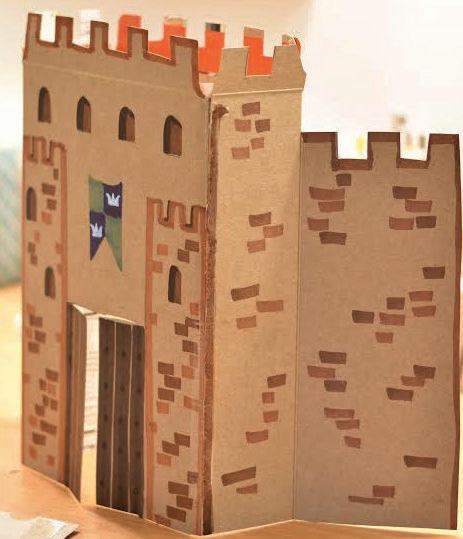

You don’t need a cabinet full of arts and crafts supplies to get your DIY on. Finding items to create with can be as easy as go ing through your pantry.
Boston-based craft blogger Holly Czapski has always had a knack for design; seeing the potential in items we often just toss in the trash. Here, she’s sharing two ideas to repurpose those cereal, pasta, or mac and cheese boxes into kid-friendly crafts.
Earth Day, on April 22, is a perfect time to teach our children the value in finding new ways to use old items - and how fun it can be, too! For more recycled crafting ideas, visit Czapski’s blog rightnowcrafts.com.
Solar Powered Letters These statement-making Solar Powered Letters go together in minutes, using whatever boxes you have on hand. Tissue paper catches the light for a cheerful pop of bright color. The boxes stand up on their own, and you can stack and arrange them in all kinds of fun ways. Directions: YOU’LL NEED:
an empty box from crackers, cereal, cookies, etc. small piece of tissue paper, any color regular and (optional) double-sided tape scissors or craft knife a pencil
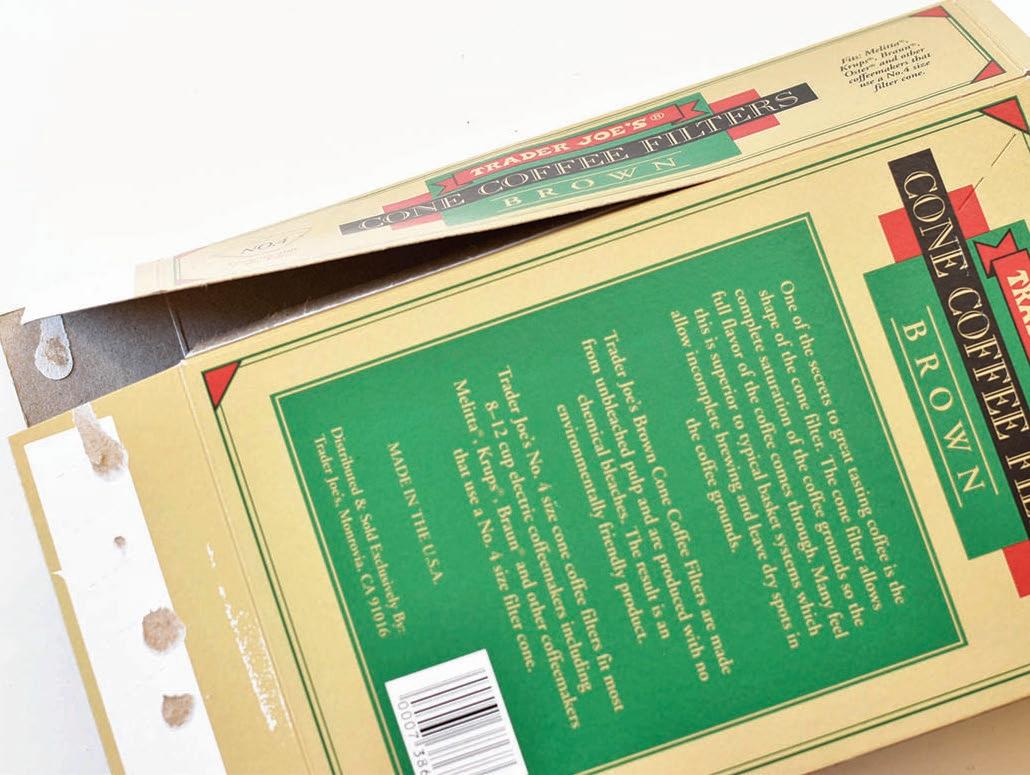

1. Open up the bottom flaps and side seam by gently separating them. If the glue is stubborn try starting from the other side. It’s okay if the paper peels. Bend all of the factory folds backwards - including the very narrow side flap - so the box will be easier to put together later. On one of the main panels, draw an letter – make it extra-bold to let lots of light through. Leave about a one-inch margin of box all around.

2. Cut out the letter with scissors (you can make a starter hole with a pin) or with a craft knife. Save any inside pieces you cut out from B’s, P’s, O’s, etc. Cut out almost all of the other main panel, leaving about 3/4” all around.


3. Cut a piece of tissue paper large enough to cover the whole letter. Lay your tissue paper over the letter, on the printed side of the box. Tape around the edges in several places. If you have any inside pieces from P’s, B’s, etc. stick them onto the outside of the tissue paper using double-sided tape or regular tape wrapped around itself sticky side out. Support the tissue paper from behind so you can press without tearing.

4. Fold the box flat to put the side seam back together and tape it closed. I like to have the very narrow flap underneath for a neater and stronger seam. Tape the top and bottom of the box closed. That’s it! Your awesome new letter is ready to brighten your day. Set it anywhere it can catch a little light.
Tips: If your tissue fades or tears, just peel off as much of the old paper as will come off easily and tape in a new piece through the open back . You can change the color that way too. If part of your letter won’t la y flat, tuck a little piece of double-sided tape under neath the problem piece, and press it to the tissue paper (with one hand behind the tissue paper for support) and it will stay put.
YOU’LL NEED: any empty cereal box, scissors, pencil, regular tape
Directions:
Pull out those shoeboxes full of knights, dragons, and pink and purple action figures of all kinds and give them a whole new stage to play on with this awesome castle, made from a cereal box. It can be a fairy-tale setting for gentler play or a serious fortification against trolls and orcs, a mythical kingdom or an actual place.
All you need is an empty cereal box, tape, and scissors. Have the basic castle finished in short order and spend as much or as little time decorating it as you like. If you make more than one you can put them together to form a larger castle or even a walled city.
1. Open the bottom flaps of the box, and open up the side seam by gently separating it. If the glue is stubborn try starting from the other end. It’s totally OK if the paper peels. Bend all of the factory folds back the other way. We’ll be putting this box back together inside-out, so refolding the folds now will make that easier.

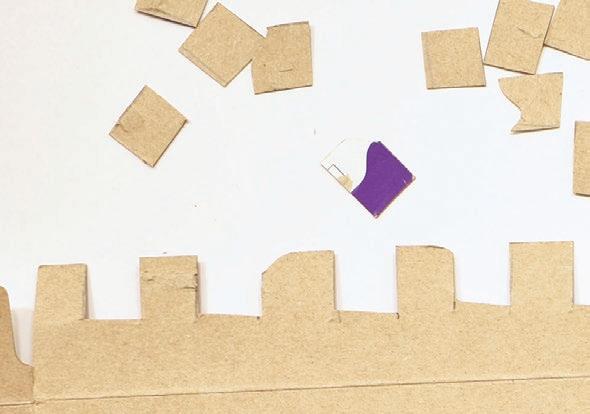
2. Cut off and save about 1/2” of the bottom of the box, including all of the flaps. (This will be the optional roof of the castle.)
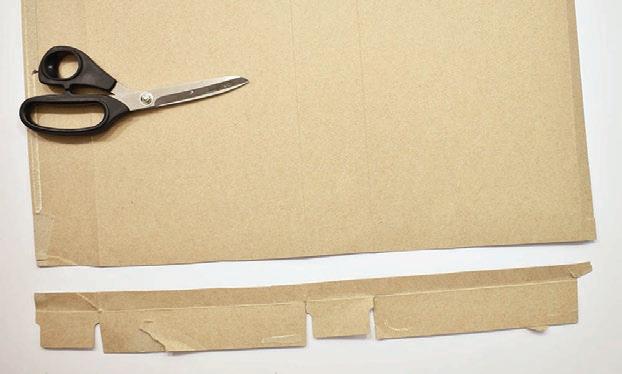


3. Draw lines for cutting out the teeth at the top of your castle: On the long flaps, start by drawing two lines in the middle. Then draw three or four more lines to each side. Whether you choose to make three lines or four, make the same number of lines on each side. Put teeth on both long flaps. Draw two lines on each of the small flaps.

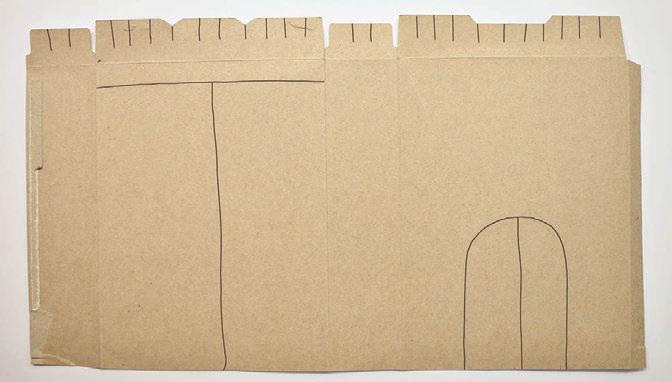
4. Find the panel that sits between the two side panels. Draw a big T here for the side walls. Leave some space between the top of the T and the top of the panel. Draw your door on the other panel. I made a rounded door but yours could have a straight top or some other shape. If you have action figures that need to fit through the door, you can make it the right size for them.
5. Snip down all the teeth lines you drew, then grab and cut off every second tooth. Your teeth may be uneven heights depend ing on the box. Trim them level if you like. 6. Tape the side seam closed. This is easiest if you flatten the box down like this. (Tip: I like to tape the seam with the narrow glue flap underneath for a neater, stronger seal.) Unflatten the box back to its original shape.
Optional Roof
7. Cut the door, leaving the sides as hinges, and fold the doors open.

8. Cut up the stem of the T on the back, then out to each side, and open out the walls of the castle. Draw four tooth lines on each wall, and cut out the teeth like you did earlier.
Take that bottom strip from before and tape the tiny bit of side seam back together. Close the flaps, and seal with tape from one end to the other.

Decorate
Decorate with colored pencils or markers (you can decorate your next castle while it’s flat if you like).
Flip it over and tuck into the top of the castle. Press gently to fit it down a little way inside, so it’s secure. You may need to bend in the short ends of the roof to get it to fit. You can see in the picture where I pushed in the short ends of this one.


Tape the roof to the castle with a piece or two of tape if needed. Tip: Sometimes a corner of the castle will split a little as you are doing this. No worries - just repair the split with tape.
Double Castle
Make two castles and connect their side walls with paper clips. Or connect permanently with staples. Set up a walled city with three or more castles.

Copyright 2020 by Holly Czapski/ Right Now Crafts
Dakota Reid Andrea Alberto and Cal and Beth Rescsanski



Carlos Rolon. Submitted photo; Caroline Gilbody Photography
Life lost, life given, life shared
Stories of organ donation

When you think of organ donation, what comes to mind? For adults, deciding to give the gift of life can be as easy as checking a box at the RMV.
But kids need organs too, and that means we need pediatric donors, as well.
Last year in the United States, 115 children died waiting on a donor organ, according to the Organ Procurement and Transplant Network. Currently, nearly 2,000 children under the age of 18 are on the national transplant waiting list; more than 500 of them are between 1 and 5 years old.
In the New England area alone, there are 66 children waiting for a lifesaving transplant, according to New England Donor Services.
Children in need of an organ transplant often wait BY AMANDA COLLINS BERNIER
longer than adults for available organs. As pediatric patients, they may face unique challenges.
“An organ must be size matched, it does not need to be age matched,” said Dr. Betsy Blume, Medical Director of the Heart Transplant program at Boston Children’s Hospital. Therefore some older children can get organs from small adults, but in many cases, an organ for a child must come from another child.
Pediatric organ donation is a difficult subject. The loss of a teen, child or infant is always tragic, and the option of organ, eye and tissue donation is especially hard on parents, who are the decision makers in such an event.
Here, you’ll meet families on all sides. A father who faced an unthinkable decision after losing his teen in a car accident. A boy whose life is on hold until he receives a new heart. And two moms brought together by a lifesaving gift. A donor They say when you have a child, a piece of your heart walks outside your body. For John Reid, that piece beats inside the chest of a man he’s never met.
Six-hundred miles away from Reid's home in Virginia, a man in Massachusetts lives, in part, because Reid’s 16-year-old son died.
Dakota Reid was that popular, gregarious kid that everyone loved. After high school, he wanted to become a welder. His father remembers him with honesty; he had a heart of gold, but he could be testy, too.
“I guess he was your typical teen,” Reid said. In January 2019, Dakota was a passenger in a friend’s car that was t-boned on a busy Virginia highway. Both boys, juniors in high school, were killed in the
accident.
“As soon as they told us, my heart was torn from my chest,” said Reid. “It just ripped my heart out.”
In the midst of unspeakable grief, Reid faced a gut-wrenching decision. Hospital staff asked if he would consider donating Dakota's organs.
One person, like Dakota, can donate up to eight lifesaving organs -- the heart, two lungs, two kidneys, the liver, pancreas, and intestines. One eye and tissue donor can also save or improve the lives of up to 50 people.
It was something Reid had never really considered, after all, who thinks of such a tragedy involving their child. But he took some comfort in knowing that he could turn his loss into life for someone else; in knowing that in some way, Dakota could live on through others.
Reid remembers walking alongside Dakota’s hospital bed as it was wheeled to the operating room. Lined with doctors, nurses and staff, he said it felt like it was a mile long -- the longest mile of his life, but also somehow the shortest.
“Then, it was time to say our ‘see you soon,’” he said.
In the 15 months since he lost his son, Reid has ridden the ups and downs of grief. There’s an aching, gaping hole in his heart.
But letters from strangers have brought him some peace.
“I got a letter from a 21-year-old young man telling me he can see for the first time and thanking us for Dakota’s corneas. Got a letter from a farmer thanking us for Dakota’s pancreas and kidney,” he said.
Reid selected the recipient of Dakota’s other kidney -- a 19-year-old man his niece knew who had been living on dialysis. After the transplant, the teen’s family threw a cookout for Reids in Dakota’s honor. But the most poignant moment since Dakota’s passing happened just recently. It came by way of a package, sent from Massachusetts.
Reid broke down in tears as he opened the special gift he received in the mail: a teddy bear that played his late son's heartbeat.
The gift came from Bob; the recipient of Dakota’s heart. The Massachusetts man, who had been on life support after a heart condition suddenly worsened, was given a second chance at life when he received the heart transplant. To show his gratitude, he taped his heartbeat during an annual checkup and put the recording in a Build-a-Bear dressed in a shirt that said "Best Dad Ever."
Sometimes, when he’s thinking of his son, Reid will press the bear’s paw and listen to the heartbeat. It reminds him of the gift Dakota gave to so many families.
“I want people to know how powerful it is to give the gift of life. It allows God to heal and comfort you. It brings you peace and closure,” he said. “My son is a hero, and through a miracle, he lives on.” A need Six-year-old Carlos Rolon awaits such a miracle.
For the last four years, Carlos has been waiting for a new heart. For the last six months, he’s been living at Children’s Hospital in Boston. About 60 miles away from his home in Worcester, over an hour away from his bedroom, his friends, and his big brother and sister, he stays within the walls of the hospital, waiting for the transplant. He's not strong enough to leave, doctors say, though you might not know it from his playful smile.
We met Carlos 187 days into his stay, when he showed us the hospital’s massive fish tank and his favorite spot to linger, in front of a giant kinetic ball sculpture. Toting a wind-up blue dinosaur and sporting a Toy Story backpack, he looked like any other first-grader. But instead of books and toys, the backpack holds a pump that delivers his heart medication through an IV. And just months before, he was too sick for even this walk around the hospital lobby.
Doctors and needles are nothing for new for Carlos. His mom, Sheena Cossette, learned he had a heart condition when she was five months pregnant. Born with an unbalanced atrioventricular canal defect, an abnormality of one of the four chambers of his heart, Carlos endured four heart surgeries before he turned 2. Then, doctors decided he needed a transplant.
When Carlos was first placed on the transplant list in early 2016, he was a status 1B; sick enough to need a transplant, but well enough to live at home. For his family, everything changed. “When you’re waiting, it’s like you’re living on eggshells,” Cossette said. “The minute you get the call [that an organ is available], you have to be ready. I used to stay up at night because I was afraid the call would in the middle of the night, and I wouldn’t hear it.”
Still, she wanted Carlos to have as normal of a childhood as possible. She encouraged his goofy and playful personality and fought for him to have a one-on-one nurse so he could go to kindergarten. Last year, he was the first child in the city of Worcester to go to school while on milrinone, a medicine for the symptoms of heart failure that’s delivered through a continuous infusion.
But last summer, things took a turn for the worse. Carlos got an infection in his PICC line, and was septic.
Since Aug. 31, he’s been living at Children’s Hospital, spending the first 108 days there confined to his room.
Four days a week his mother stays in the hospital with him, sleeping by his bedside. The three days a week she trades off with Carlos’s dad, Cossette heads home to see her other children and work her two jobs.
“There is no date when we’re coming home, and that’s what’s getting really hard,” she said. “We’re just here until he gets his heart.”
Now a status 1A, he’s as high as a person can be on a transplant list. Carlos knows what he’s waiting for, but he’s shielded from the details.
“We introduced the idea of a transplant to him during this stay. I didn’t want to tell him too much because I didn't want to scare him, but now he knows ‘after I get my heart, I get to go home,’” said Cossette. Sometimes Carlos’s mind wanders. Will they cut him with a knife? he asks his mom. She worries about the day that he’ll ask where his new heart will come from.
“We’ll tell him it’s coming from someone who doesn’t need it anymore,” she said.
And that’s where Cossette really struggles. “My biggest struggle is knowing another child has to pass. For the longest time I felt like praying that he Organ donor Dakota Reid. Submitted photo
Carlos Rolon and his mom Sheena Cossette in the lobby of Boston Children’s Hospital. Caroline Gilbody Photography








gets a heart meant I was praying for a little child to pass,” she said. It helped, she said, to see a post on Facebook from another Worcester mom who lost her teenage son in a shooting and donated his organs.
“She said to people who received the organs, ‘please don’t feel guilty, my son is living through you,’” Cossette said.
She thinks of what she would tell someone faced with the decision of donating their child’s organs.
“It is the most selfless act. The most precious gift you could ever give is the gift of life,” she said. “Their child would be living through my son.”


A recipient For the Rescsanski family in Connecticut, the gift of life came not from loss.
Instead, they gained more than they could have imagined. “My husband calls her Cal’s ‘liver mom,’” Beth Rescsanski said of Andrea Alberto, who was a stranger to the family when she donated a piece of liver to the Rescsankis’ then-11-month-old son Callum last year.
In turn, Alberto’s children Jack and Ben refer to Cal as their “liver brother.”
For the first year of his life, little Cal never knew what it was like to not be sick. Born with biliary atresia, a rare disease of the liver and bile ducts that occurs in infants, he endured major surgery when he was just one month old.
At six months, doctors decided he needed a new liver, and Cal was placed on the transplant list. While some transplants can be done using the organs from a deceased person, Callum needed a piece of a living organ in order to give his liver the chance to regenerate. A child's liver can regenerate into a normal size within just a few weeks. A new mom looking for guidance and support, Rescsanski had been sharing much of her journey on a Facebook group for moms even before she knew Callum was sick. As fate would have it, Alberto, a single mother who lived a couple hours away in Medfield, Massachusetts, was part of the group, too.
After seeing that Cal was in need of a live donor, Alberto was among 100 moms who offered to be screened as a potential donor. She was a perfect match.
Cal would need just a piece of Alberto’s liver, but still, it was a weighty decision. Last fall, Rescsanski and Alberto, two moms connected only by social media, went out to dinner to discuss moving forward with the lifesaving transplant.
“We didn’t want to put a lot of pressure on the situation, we just wanted to do what felt right,” said Rescsanski.
But Alberto always knew that organ donation was something she was willing to do.
“I think that people think it takes someone special, or different, to do this. But anyone can,” she said. “I like to think that if it was one of my kids in need, someone would step up.”

Andrea Alberto visits her sons while recovering from surgery.

But what Alberto did was pretty special. In September, she left her two sons, ages 5 and 8, and traveled to New Haven, Connecticut for surgery.
In his own 10-hour surgery, Cal received a slice of Alberto’s liver.
In the months since the transplant, Rescsanski has watched her baby flourish. No longer jaundiced, his skin is healthy and rosey. No longer sick, he toddles around, as giggly and inquisitive as any other 15-month-old. Naturally, the moms have forged a friendship, and their families have become close. They chat regularly and have visited each other’s homes. They are both passionate advocates for organ donation.
"If you are open to the idea of donation, get more information," Alberto said. "You don't need to wait until it's a family or friend who needs an organ; odds are, they never will. But someone else's loved one already does need your organ.”
Post-surgery, Alberto took to Facebook to express what the experience meant to her.
“They tell you in donor evaluation that you, the donor, don't 'get' anything out of donation. Looking back … I disagree,” she wrote. “My liver couldn't have asked for a better home. It's going to go to Kindergarten and learn to drive a car. It will get to eat lots of birthday cake and play sports and go to the prom. How lucky is that liver? And honestly, it has never looked cuter. I can't wait to see the places Cal takes it.”
What potential donors should know If you’ve ever thought about organ donation, know this: anyone can be a potential donor regardless of age, race or medical history. You can sign a donor card, state your wishes on your driver’s license, or register through Donate Life (donatelife.net).
Adults can also be living donors, choosing to donate a kidney, bone marrow, or part of their liver to someone in need.
Teenagers ages 15 to 17 may register their intent to be an organ, eye and tissue donor while registering for a driver’s license.
But what about children? Perhaps we miss an opportunity to talk about organ donation when kids aren’t sick. Many families, like the
Alberto with her sons Jack and Ben, visit with Beth and Cal Rescsanski. Facebook photo; Caroline Gilbody Photography
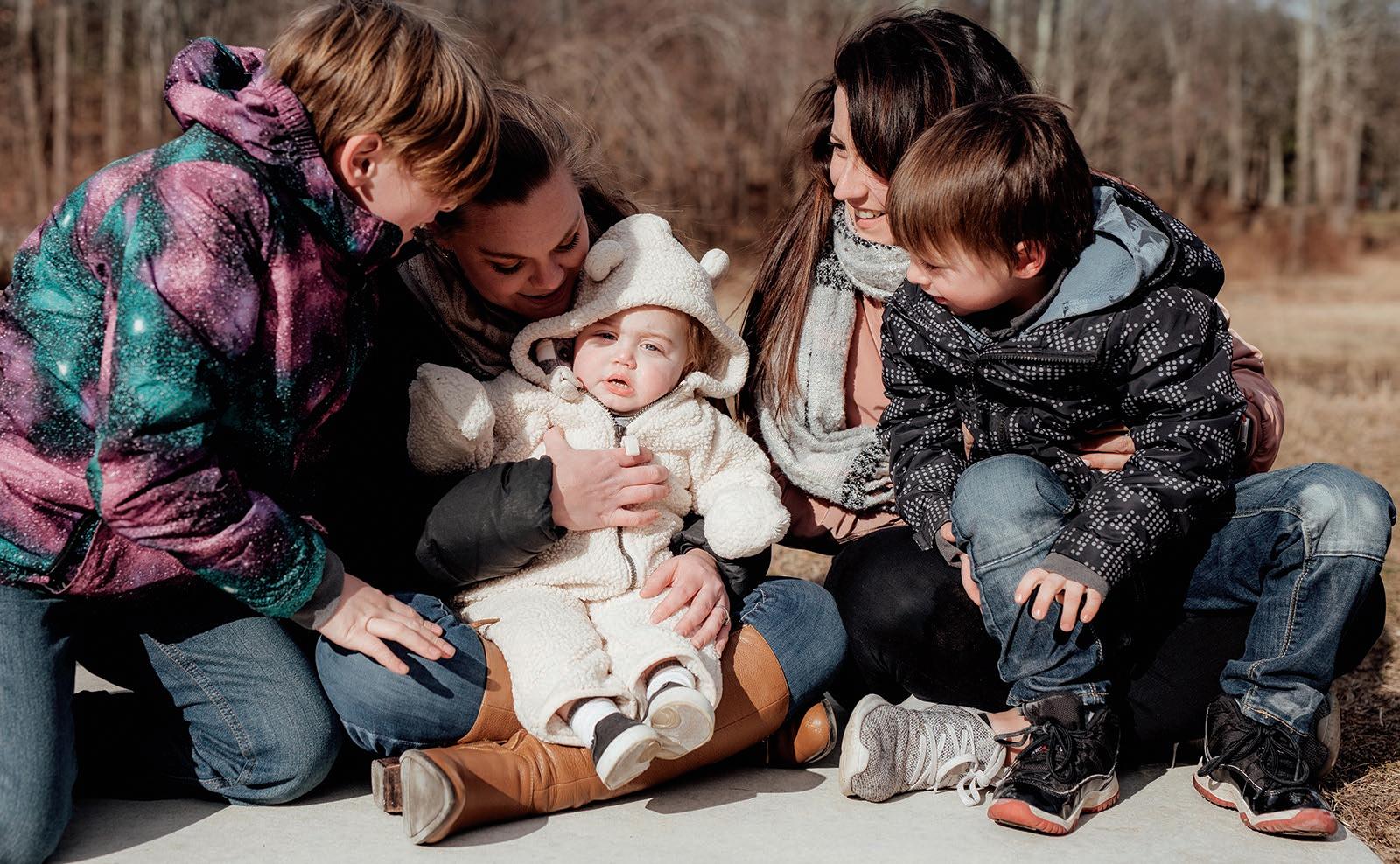
Reids, only begin thinking about it after an unspeakable tragedy. Then, parents are presented with a huge decision in the worst moment of their lives.
“It is intimidating to discuss organ donation with children and family members,” said Dr. Blume. “Talking about organ donation at the dinner table while everyone is healthy allows for the discussion and decisions to be made as an everyday decision.”
While organ donation among kids and teens is an understandably difficult topic to broach, parents’ misconceptions may further complicate the process. According to a 2018 study by C.S. Mott Children’s
Facts for Donate Life Month
April is Donate Life Month. Here are some facts about organ transplants and needs: • Most children under the age of 1 are waiting for a liver or heart transplant
• Most children ages 11–17 are primarily waiting for a donor kidney transplant; followed by donor liver or donor heart
• When a potential donor is under the age of 18, the parent or legal guardian always has to authorize the donation
• An average of 68 organ transplants are performed every day in the United States
• About three-quarters of all live donors are relatives of their recipient, most commonly a brother or sister
• On average, 106 people are added to the nation's organ transplant waiting list each day - one every 14 minutes.
Hospital, parents of younger children are less than comfortable with organ donation. Only 17% of parents of children 0-14 years said they would like to learn more about organ donation. About half of parents reported major concerns about whether their child would get all treatment options in a life-threatening situation.
Other concerns were not knowing if they could decide which of their child's organs would be used for transplant, and the potential cost of organ donation.
Few parents said their religion did not support organ donation, while 6 percent of parents said their only major concern was that they just didn't want to think about organ donation.
"It is important for parents to know that registering their child as an organ donor will not negatively affect medical care in any way, nor would their child experience any pain," said Dr. Gary Freed, co-director of the study. "There is also never a cost to the donor's family for organ donation."
Dispelling misconceptions could help parents feel more at ease with discussing the uncomfortable topic, he said.
“We may benefit from a national, organized mechanism for parents to gain information regarding organ donation,” Freed said.
Parents can learn more about the subject at donatelife.net or unos.org.
BAYSTATEPARENT 19 The impact In 2018, more than 1,800 children received life-saving transplants, matched from over 800 pediatric organ donors. While the donors ranged in age from newborns to 17, most were between 11 and 17 years old — though in 2018, more than 100 pediatric organ donors were babies under the age of 12 months.
Additionally, every year, thousands of pediatric cornea and tissue donors help restore sight and save and heal lives.
Each number represents a child getting a chance at life.
“We should highlight the message of ‘gift of life’ of our organs once we do not need them anymore,” said Dr. Blume.
very special people

Autism Your child has been diagnosed with
What happens next?
Your child is on the autism spec trum. The diagnosis is life altering for parents, siblings, grand parents, and everyone else in your child’s immediate life. You are not alone. Autism is common, and in one way or another, we all know of someone who has been diagnosed with ASD. The Center for Disease Control and Prevention (CDC) estimates that one in 59 children have ASD and it is four times more prevalent in boys than girls.
Still, as prevalent as it may be, it can be difficult to know where to start or what you can do to help your child when you first get the diagnosis. Here’s a guide to the first steps.
After diagnosis The best place to start is the diagnostic report. The pediatrician who diagnosed your child will help direct your first steps by providing their recommendations for treatment. The pediatrician’s report essentially serves as a “road map” for your family.
The pediatrician will list the treatments that would be beneficial for your child based on the skills that were observed during the assessment. Among these, some recommendations are speech therapy, occupational therapy, and applied BY EILIANIE M. ALVELO behavior analysis (ABA).
Most families have heard of the first two therapies. ABA is an evidence-based approach that uses the principles of how learning takes place to teach skills that will increase your child’s abilities in the areas of self-care, communication, social interac tions, and play skills. ABA can also work to help decrease challenging behaviors that may interfere with learning and daily life skills.
Finding service providers The best way to find the services that your pediatrician recommends is through the Early Intervention (EI) program. If your child is not part of an EI program, you can visit the Massachusetts Early Interven tion Division website at www.mass.gov/ orgs/early-intervention-division and find a certified EI program. The process is as easy as calling the number 1-800-905-8437, and anyone can make a referral (a doctor, teacher, parent, friend, etc.).
Your EI coordinator will help you navi gate a list of providers for the services that your child needs. It is recommended that you interview or meet with three to five dif ferent providers before making a decision. Each provider will conduct an intake and give you an overview of the services that are available for your child. Provider intake sessions Coordinating intake sessions (inter views) with service providers is your next step. Each service provider will give you an overview of who they are and what they offer. Ensuring a good match for your child can really only be determined by getting acquainted with each service provider. Observe their interaction. How well did the provider interact with your child? How well did your child interact with the provider?
The intake session is a great opportunity to ask the questions that are important to you and start learning about the different service providers. Also, asking questions during these intakes will make you feel empowered to start your journey as your child’s “voice.” There are some questions that you might consider asking. How soon can services start? ASD has become a common diagnosis. Many provid ers face the challenge of not having enough staff to meet increased demand for ser vices, which means there may be a delay in starting direct care services. Additionally, not all providers will be able to provide services within the schedule that works for the family. For example, you might be look ing for services in the evening after you get home from work, which is a very popular time of the day for sessions. Children who go to a full day school program can only receive in-home ABA services at that time, so there might be a longer wait time for that time slot. Don’t get discouraged. Your child can start with as few as four hours per week and then increase their time with a provider when staff becomes available. The most important thing is to start ser vices as soon as possible.
What is the process for starting ser vices? Even though your child has already been assessed by a doctor, a Board Cer tified Behavior Analyst (BCBA) must also conduct an assessment. After a service provider is selected, the BCBA will request an authorization from the insurance to



conduct an initial assessment. This assessment is not meant determine whether your child has autism not, but rather to identify what your child can do. Based on your child’s performance levels, an individualized treatment plan will be developed and submitted to the insurance. Once the initial treatment plan is approved by the insurance (which may take some time), services can begin.
What will happen when my child turns 3 years old? EI ser vices end one day before a child turns 3, which means that every thing that a child receives through the program will be discontinued. However, many insurance compa nies cover ABA services and the BCBA will help the family transi tion from EI to insurance-based ABA services. Sometimes, there is a waiting list for this type of ser vice, which is why is important to ask providers how they transition from one program to the other. Find out upfront if this continu ation of services is available so there is no gap and your child may make this transition with ease. What are the qualifications of the staff who will be working with my child? A BCBA must have a Master’s degree and a Registered Behavior Technician (RBT) needs to pass a comprehensive exam. In order to maintain this certification, RBTs need continuous supervision by a BCBA. Make sure that your insurance offers ABA coverage. Many insurance companies do not cover ABA services unless they are provided by, or overseen by, a BCBA.
What will my role be in my child’s treatment sessions? Learn strategies to help you carry over what is taught during the session. Every now and then (and especial ly when the BCBA is present), you can sit and watch the sessions and ask questions about programming. BCBAs will also conduct parent training sessions where you will learn about the basic principles of behavior analysis and how you may use these principles outside of the therapy sessions. In this way, you are helping your child to generalize skills across time, people, and settings. The more opportunities your child gets to practice a particular skill, the more likely he or she is going to master it and move on to something else. Additionally, you will be part of the treatment planning process by sharing with your provider what skills you would like to see your child learn. Although your BCBA will be able to identify appropriate goals through the assessment pro cess, you can also share what you would like your child to be able to do. For example, parents often mention that they would like to see their child increase communi cation, sleep through the night, eat more foods, and use the bathroom independently. These are all behavioral areas in which an ABA program can help improve.
Will you help us navigate special education services and Individualized Education Program (IEP) meetings with us? Your BCBA can give a professional opinion on how to work together toward similar goals. As your child gets closer to his or her third birthday, it is appropriate for your school team members and the members from your in-home ABA and Early Intervention team to col laborate, as it ensures consistency. For example, if there is a behavior that you’re trying to decrease, make sure everyone is responding in the same manner so that it is consistent for your child.
After your intake with the service provider is complete and you’ve asked all of the above questions, take some time to evaluate your meeting. How did they make you feel? Is there a connection? How many hours can they provide?
Making a decision Review your notes after meeting with all the service providers and think about who is the best match for your child’s needs. Ask other parents who have been through this process what factors influenced their decision and how satisfied they are with the services that they received from their provider.
Lastly, familiarize yourself with community resources such as Autism Speaks by visiting their website autismspeaks.org, as well as the Massachusetts Division

of Health’s website mass.gov/ autism-resources-for-families. By learning all that you can, you’ll be the best advocate for your child.
Eilianie M. Alvelo, M.A., BCBA, LABA was born and raised in Comerío, Puerto Rico, and moved to Western Mass. in December 2008 af ter her family struggled to find treatment for her nephew with autism. She is a Behavior Analyst based in the Springfield office of Behav ioral Concepts (BCI). BCI provides Applied Behavior Analysis (ABA) services to children diagnosed with ASD and their families throughout Massachusetts.









